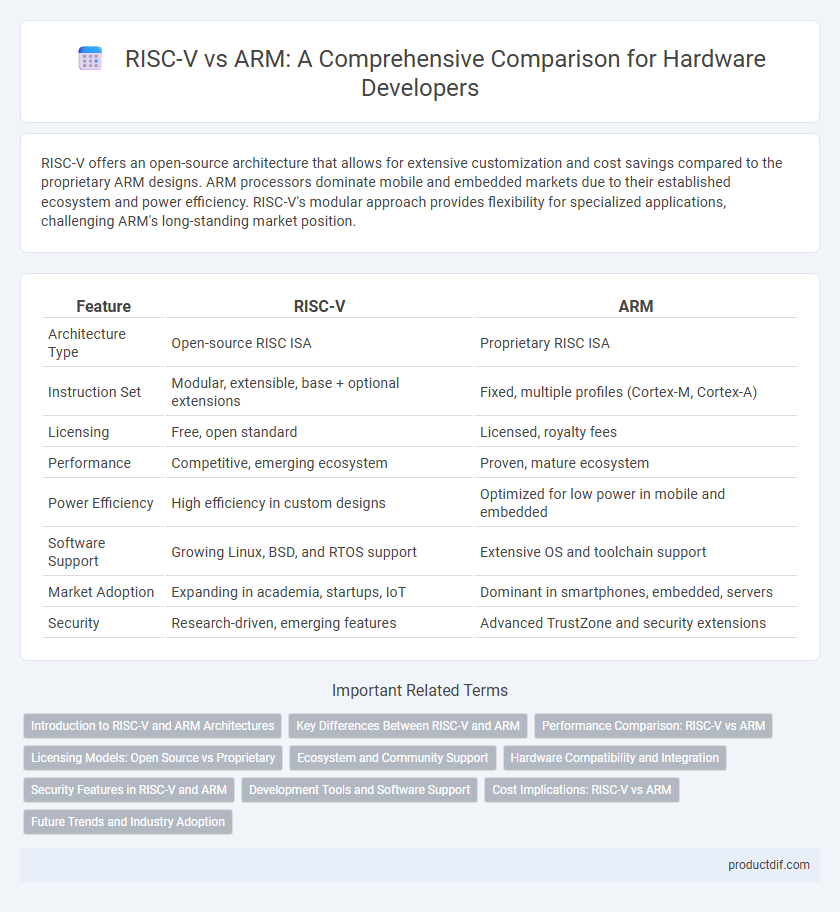RISC-V offers an open-source architecture that allows for extensive customization and cost savings compared to the proprietary ARM designs. ARM processors dominate mobile and embedded markets due to their established ecosystem and power efficiency. RISC-V's modular approach provides flexibility for specialized applications, challenging ARM's long-standing market position.
Table of Comparison
| Feature | RISC-V | ARM |
|---|---|---|
| Architecture Type | Open-source RISC ISA | Proprietary RISC ISA |
| Instruction Set | Modular, extensible, base + optional extensions | Fixed, multiple profiles (Cortex-M, Cortex-A) |
| Licensing | Free, open standard | Licensed, royalty fees |
| Performance | Competitive, emerging ecosystem | Proven, mature ecosystem |
| Power Efficiency | High efficiency in custom designs | Optimized for low power in mobile and embedded |
| Software Support | Growing Linux, BSD, and RTOS support | Extensive OS and toolchain support |
| Market Adoption | Expanding in academia, startups, IoT | Dominant in smartphones, embedded, servers |
| Security | Research-driven, emerging features | Advanced TrustZone and security extensions |
Introduction to RISC-V and ARM Architectures
RISC-V is an open-source instruction set architecture (ISA) designed for flexibility and customization in hardware development, promoting innovation and cost efficiency. ARM architecture, developed by ARM Holdings, is a proprietary ISA known for its energy-efficient performance in mobile and embedded systems, dominating the smartphone market. Both architectures emphasize reduced instruction complexity but differ in licensing models and ecosystem support, influencing their adoption in various applications.
Key Differences Between RISC-V and ARM
RISC-V is an open-source instruction set architecture (ISA) that offers modularity and extensibility, enabling customized hardware designs, whereas ARM is a proprietary ISA with a fixed architecture optimized for power efficiency and performance in commercial devices. RISC-V's simplified ISA promotes innovation and reduces licensing costs, making it ideal for academic research and emerging applications, while ARM's mature ecosystem supports a wide range of established consumer electronics and embedded systems. The architectural flexibility of RISC-V contrasts with ARM's comprehensive tooling and software support, influencing the choice between them based on project requirements and market considerations.
Performance Comparison: RISC-V vs ARM
RISC-V processors demonstrate competitive single-core performance with ARM by leveraging a simplified instruction set that enhances pipeline efficiency and reduces power consumption. ARM's mature ecosystem offers advanced out-of-order execution and higher clock speeds, delivering superior multi-core performance in high-end applications. Benchmark tests reveal RISC-V excels in customizable, lightweight workloads, while ARM dominates in complex, performance-intensive environments.
Licensing Models: Open Source vs Proprietary
RISC-V utilizes an open-source licensing model that allows hardware designers unrestricted access to its instruction set architecture (ISA), fostering innovation and customization without royalty fees. ARM operates under a proprietary licensing framework, requiring manufacturers to pay licensing fees and adhere to strict usage agreements, which often limits design flexibility. The open-source nature of RISC-V enables broader collaborative development and cost efficiencies compared to ARM's controlled and monetized ecosystem.
Ecosystem and Community Support
RISC-V offers an open-source instruction set architecture fostering rapid innovation and customization, which attracts a growing and diverse community of developers, researchers, and companies contributing to its ecosystem. ARM benefits from a mature and well-established ecosystem with extensive software toolchains, libraries, and industry partnerships, providing robust commercial support and widespread adoption in various markets. The evolving RISC-V ecosystem is closing the gap with ARM, driven by collaborative development and increasing availability of hardware platforms and development tools.
Hardware Compatibility and Integration
RISC-V offers open-source hardware compatibility, enabling seamless integration with custom silicon designs and flexible IP core configurations. ARM's established ecosystem provides extensive hardware compatibility with a wide range of commercial processors and development tools, ensuring robust integration across diverse platforms. Hardware integration with ARM often benefits from mature software support and standardized interfaces, whereas RISC-V enables tailored hardware solutions with evolving but less standardized toolchains.
Security Features in RISC-V and ARM
RISC-V incorporates customizable security extensions such as physical memory protection (PMP) and secure enclaves, enabling tailored hardware security implementations for diverse applications. ARM's security features include TrustZone technology, which creates a secure execution environment to isolate sensitive operations and prevent unauthorized access. Both architectures emphasize hardware-based security, but ARM's mature ecosystem offers widely adopted solutions, while RISC-V provides openness and flexibility for novel security designs.
Development Tools and Software Support
RISC-V offers open-source development tools such as GCC and LLVM, enabling flexible customization and cost-effective deployment for hardware developers. ARM benefits from a mature ecosystem with extensive proprietary and third-party software support, including optimized compilers, debuggers, and integrated development environments tailored for embedded and mobile applications. The robustness of ARM's development toolchain ensures faster time-to-market, while RISC-V's expanding tool support continues to close the gap in versatility and community-driven innovation.
Cost Implications: RISC-V vs ARM
RISC-V offers significant cost advantages over ARM by providing an open-source instruction set architecture, eliminating expensive licensing fees and royalties associated with ARM's proprietary designs. This cost reduction enables manufacturers, especially startups and IoT developers, to allocate more resources to innovation and customization. However, ARM's extensive ecosystem and mature tooling can offset initial costs through faster development cycles and broader software compatibility.
Future Trends and Industry Adoption
RISC-V architecture is rapidly gaining traction due to its open-source nature, fostering innovation and cost-effective customization in hardware design. ARM maintains strong industry adoption with its extensive ecosystem and optimized power efficiency, particularly in mobile and embedded devices. Future trends indicate increasing RISC-V integration in edge computing and IoT applications, while ARM continues evolving with advanced AI and machine learning hardware support.
RISC-V vs ARM Infographic

 productdif.com
productdif.com